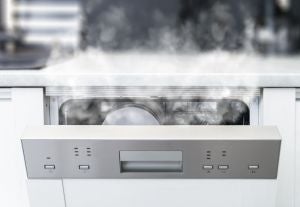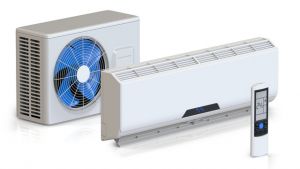When your fridge’s low hum turns to a noisy death rattle and then packs up, or your dishwasher floods your kitchen with each load, then it’s time to replace your whitewear. While cost is always a consideration with any new appliance, when buying electronic devices energy efficiency is also a major concern. For not only will a power-hungry fridge or heater hit you with extra running costs, if you don’t purchase green energy, the carbon footprint of your electricity generation will also hurt the planet. That’s why it’s essential to look at products’ Energy Star Ratings.
Want to know where to get green power click here!
The Energy Rating Label, displayed on all new whiteware appliances, televisions, computer monitors and heat pumps, offers guidance about a product’s energy use.
The Energy Efficiency and Conservation Authority’s Energywise website advises that the label features:
- A star rating – the more stars, the more energy efficient the appliance
- Annual energy consumption – a kWh per year figure, based on average expected use.
For consumers seeking to compare the energy efficiency and annual running costs of different appliances, Energywise’s Rightware tool provides information on a range of models.
Another useful tool is Energywise’s running costs calculator, which shows the relationship between an energy rating and the amount of energy used, and how much an appliance will potentially cost to run per year.
Using the running costs calculator (which calculates annual running costs using 26c per kWh), Canstar has crunched the numbers across a range of appliance categories, demonstrating the sort of savings more energy-efficient models can provide.

Dishwashers
The below numbers are based on running a dishwasher at the large end of the scale, used once every day. Of course, it’s worthwhile keeping in mind that frequency of usage can vary dramatically from one household to the next.
Usage details
Capacity (place settings) – 15
Average number of uses per week – 7
| Star rating | Annual energy use | Annual running cost | Greenhouse gas emissions |
| Two | 504 kWh | $132.20 | 0.07 t |
| Four | 247 kWh | $64.78 | 0.03 t |
The five-year outlook
Based on the above usage, the running costs over five years are:
- Two-star dishwasher – $661
- Four-star dishwasher – $323.90
This is a total difference in running costs of $337.10
These numbers do give pause for thought, especially so for an appliance that may well last ten years, with even a half-star difference between models having the potential to add up significantly over time.

Fridge/Freezers
Consumers have a huge range of fridge/freezer options to choose from in the 350 l to 450 l bracket. We’ve gone straight down the middle, and taken a look at the running costs that can be expected for a 400 l model.
Usage details
Volume of fresh food compartment – 285 l
Volume of freezer compartment – 115 l
| Star rating | Annual energy use | Annual running cost | Greenhouse gas emissions |
| Two | 525 kWh | $137.58 | 0.07 t |
| Four | 311 kWh | $81.57 | 0.04 t |
The five-year outlook
Based on the above usage, the running costs over five years are:
- Two-star fridge/freezer – $687.90
- Four-star fridge/freezer – $407.85
This is a total difference in running costs of $280.05
Given that fridge/freezers can potentially deliver well over 10 years of use – before being put out to pasture in the garage as a beer fridge – the energy cost savings could really stack up.

Televisions
Over the years, televisions have steadily grown bigger and slimmer, and are far removed from the energy guzzling plasmas of just a decade ago. For our comparison, we’ve opted to run the numbers on a 50” model used for an average of four hours per day. Unlike the other appliances in this list, the running costs calculator provides calculations for up to 10-star models.
Usage details
Screen size – 50”
Running hours per day – 4
| Star rating | Annual energy use | Annual running cost | Greenhouse gas emissions |
| Four | 150 kWh | $39.47 | 0.02 t |
| Six | 98 kWh | $25.76 | 0.01 t |
The five-year outlook
Based on the above usage, the running costs over five years are:
- Four-star television – $197.35
- Six-star television – $128.80
This is a total difference in running costs of $68.55
If you’re looking to get around eight years of use out of a new television, energy efficiency is an important component to pay attention to, and more energy-efficient models could well deliver significant long-term savings.

Heat pumps
As advised via Energywise, heat pumps are the most efficient way of using electricity to heat a home. However, they can also be comparatively expensive at the point of purchase. As the below figures demonstrate, greater energy efficiency can make a big difference to electricity costs over time.
Usage details
Number of months used for heating – 4
Typical hours used per day – 6
Heat output – 4 kW
| Star rating | Annual energy use | Annual running cost | Greenhouse gas emissions |
| Two | 585 kWh | $153.41 | 0.08 t |
| Four | 447 kWh | $117.31 | 0.06 t |
The five-year outlook
Based on the above usage, the running costs over five years are:
- Two-star heat pump – $767.05
- Four-star heat pump – $586.55
This is a total difference in running costs of $180.50
Heat pumps are typically a long-term investment, with a potential lifespan of well over 10 years, and it is certainly worthwhile getting out the calculator and running through the numbers in determining the best option for your household.

Clothes Dryers
We’ve taken a look at the numbers for an 8 kg capacity clothes dryer, factoring in the likelihood of increased usage in the cooler half of the year.
Usage details
Capacity – 8 kg
Average number of uses per week in the cooler half of the year – 4
Average number of uses per week in the warmer half of the year – 2
| Star rating | Annual energy use | Annual running cost | Greenhouse gas emissions |
| Two star | 1,081 kWh | $283.60 | 0.15 t |
| Four star | 781 kWh | $204.90 | 0.11 t |
The five-year outlook
Based on the above usage, the running costs over five years are:
- Two-star clothes dryer – $1,418
- Four-star clothes dryer – $1,024.50
This is a total difference in running costs of $393.50
The numbers certainly add up over time, and households would be well served to carefully assess their requirements for a clothes dryer that will likely last over five years. Though, of course, if you dry your clothes outside whenever possible, you’ll save even more money and earn greenie kudos, to boot!


Share this article